Introduction
Effort and time can transform the presentation of content into an active rather than passive experience. “Active” comes from the recognition that you are engaging a thinking human being in your eLearning unit. “Passive” comes from the belief that an instructor need only make content available to students.
Actively engaging students is a challenge. Content may be inherently motivating; oftentimes, it is not. This is especially true when we don’t include interaction, which may involve a reflection, a decision, a counterpoint, or some thinking activity. To engage students in the content, we may need to draw upon their natural curiosity, emotions, intrigue, thrill of surprise, etc. We can do that by wrapping the content in a situational challenge.
An example
A vivid example of a situational challenge is presented by a learning site called Who Killed William Robinson?
http://www.canadianmysteries.ca/sites/robinson/home/indexen.html
The objective of the resource is to promote historical understanding through the examination of prima facie documents from a particular period of time. In the case of Who Killed William Robinson, the documents are based on nineteenth century life on Salt Spring Island, an island off the coast of British Columbia. As the authors Ruth Sandwell and John Lutz tell us, the island was home to several African American families who fled slavery in the United States before the civil war.
From a teaching and learning perspective, the site could have been presented as a collection of documents that give students a first hand look at a settlement from this time period. The murder of William Robinson and the conviction of an aboriginal man for the crime could have been just one of the many stories told through the court documents, diaries, inquests, letters and drawings that were archived from this period. The authors however used a murder to drive students into a deeper interrogation of the archival documents and puzzle over a Canadian mystery.
Understandably, some instructors may take issue with a whodunit approach. The underlying point is that a situational challenge plays a role in moving the instruction from a passive, pedantic, instructor-centered experience to one that leads students through an active inquiry that elevates the process of historical understanding above the rote learning of historical facts.
Another example
A marketing instructor could help students understand the basics of the marketing mix: product, price, promotion, etc. by diligently describing each component of the marketing mix. In this type of presentation, students are asked to pay careful attention to the details and trust in the instructor that this information will be useful to them.
Alternatively, students could be placed in a situation where they must consult resources to decide how high to set the price of a product, how much return they should expect from investing in the product and improving its quality, and how much they should invest in promoting the product. The situation helps drive the student to consult resources and be better informed of the trade-offs.
A simpler example
Who Killed William Robinson? is clearly an investment of time and a labor of love. I’ll choose a simpler example to make the point that we can transform our content with a few basic techniques. Let’s build a simple working example. Let’s imagine that we are using an online unit to introduce instructors to the concept of Open Educational Resources. Open Educational Resources, or OER, are openly licensed resources that educators can freely use for the benefit of their students.
To understand OER and effectively use them, educators must understand intellectual property issues and be able to list the popular educational resource libraries and where to find them. We may include a discussion of eBooks, interactive eBooks, simulations, and other types of material that are available to us as open educational resources.
As an example of a situational challenge, let’s focus on intellectual property and open licenses. We could choose to define open licenses and the public domain. We could describe each of the Creative Commons’ licenses, for example, and then quiz participants on this information. Creative Commons, incidentally, is the non-profit organization that has produced six licenses that allow intellectual property holders to share their work without forfeiting their copyright.
We can approach this from at least two tacks. First we can provide information on the licenses and then have our learner immediately make use of that information in an authentic situation rather than a quiz. Alternatively, we can make the information available as a resource. When the learner needs the information, he or she can consult the resource. The situational challenge serves as a driver or a motivator for the learner to read and process the information.
I often use the word “driver” when I think and talk about motivation. For me, driver connotes a force that compels the learners to pay attention to the content and think about it. In situational challenges, that force comes from authentic situations and genuine – not-forced – use of the content.
Another key to the situational challenge is the use of the second person point of view. Make a direct challenge. Directly cast the learner in the role of a person who is tasked with using OER without violating copyright. Addressing the learner as “you”, makes the instruction more direct and active.
The temptation, due to time constraints and lack of creativity, is to design the unit in this manner:
Content + Content + Content + Assessment
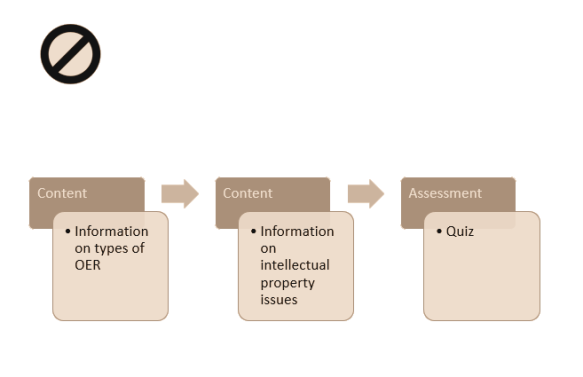
In this pattern, we push out content that students much read. Students may be required to read an opinion or point of view or remember a set of facts or understand a concept. Oftentimes, the unit lacks an engagement with the content other than the act of reading and remembering. Although the written word can provoke an intellectual and emotional response, all too often it is just something to read and to passively accept. We won’t bother showing you an example of this.
One alternative is to design in this way.
Content + Application + Assessment
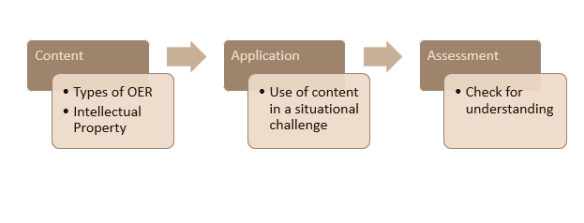
In this case, the learner almost immediately puts the content to work. The learner is asked to recall the content and make judgments about it in relationship to the situation and then apply this knowledge to the situation. Situations can be spare or they can be rich. They can start simple and become highly nuanced and complex.
Lastly, and perhaps most effectively, we can make the content accessible only when needed. In this case, the learner is challenged with a situation and has content available at his/her fingertips as resources. The emphasis here is on the interaction, with the content being used to support the interaction. This relates to the active versus the passive experience.
Application + Assessment
(supported by Content)
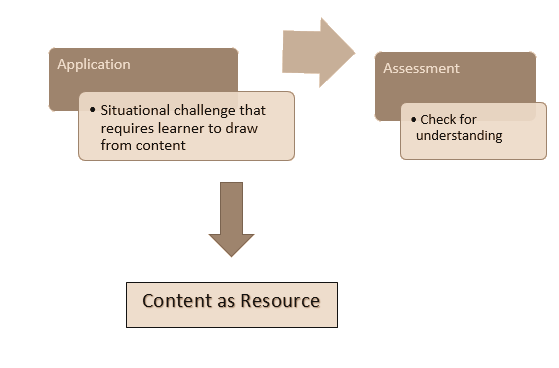
How do I create it?
In our first example, we used LodeStar and its ActivityMaker for Mobile template.
To introduce the Creative Commons licenses, I created a text page that matched each of the six licenses. These are normal LodeStar page types. I then linked to these pages from within a LodeStar page. LodeStar enables you to create internal links to content. The links can move the student to the content or display the content as an overlay so that the student doesn’t lose context. In this case, the student is learning about Creative Commons licenses just ahead of using that information in a situation.
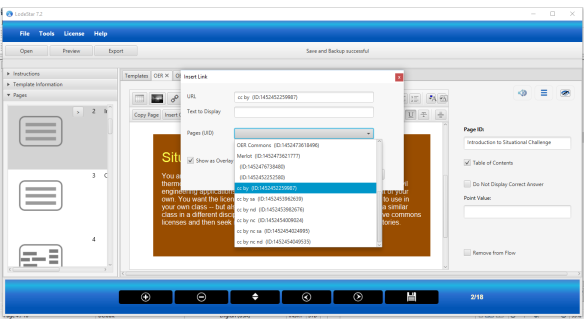
LodeStar authoring tool, editing links to internal page
The example also checks for understanding by having the student order the licenses from least restrictive to most restrictive.
Only one of several questions is included in the challenge itself.
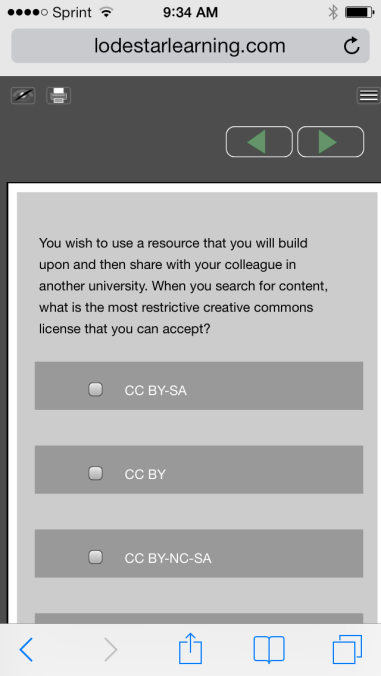
A screenshot of LodeStar activity on a Smartphone
In our second example, we used the classic LodeStar ActivityMaker template. This example differs in one significant way. The information on Creative Commons licenses is displayed as resource tiles at the bottom of the page. They are always available to the student who can consult them at any time when needed, including during the challenge. In LodeStar, the author can display and hide the resources as needed – or conditionally display resources.
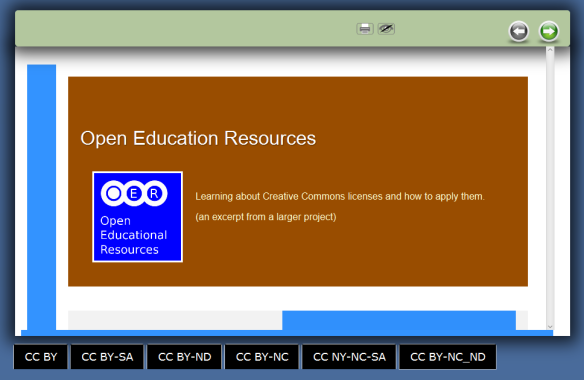
A screenshot of activity with resource tiles for each of the Creative Commons licenses
Conclusion
eLearning experiences are best when they actively engage students. With a little creativity and restructuring, instructors can transform their units from passive reading experiences to active thinking experiences. The Who Killed William Robinson? learning site is an example of an elaborate, well-produced situational challenge.
A situational challenge, however, can be simpler. A topic that is text-laden can be transformed with a little ingenuity, a short narrative and interactions that require the learner to make effective use of the content.
